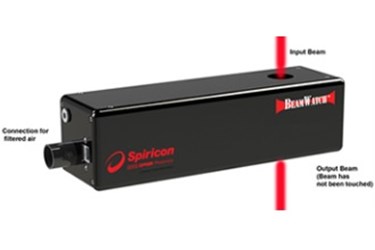Ophir Photonics Expands BeamWatch Family Of Non-Contact Industrial Beam Monitoring Systems For High Power YAG, Fiber, And Diode Lasers

New Models Feature 2D Beam Views and Smaller Diameter Focus Spot Size Measurements
Ophir Photonics, global leader in precision laser measurement equipment and a Newport Corporation company, recently announced the expansion of the BeamWatch family of industrial laser beam profilers at Photonics West. BeamWatch is the industry's first non-contact, focus spot size and position monitor for very high power YAG, fiber, and diode lasers. Designed for material processing applications, the system instantly and accurately measures laser parameters without requiring contact with the laser beam. New features include the ability to monitor smaller diameter focus spots -- down to 80µm -- for cutting and welding of thinner materials, and 2D viewing of beams to determine roundness or the presence of astigmatism.
"Laser cutting applications need the beam focused to a minimum spot size to maximize energy density and produce precision cuts," said Gary Wagner, General Manager (U.S.), Ophir Photonics. "But many factors affect spot size, including the beam delivery system, thermal lensing, focal length, and spherical aberrations. BeamWatch measures key size, position, and quality parameters, including focus spot shift, waist width, and beam propagation parameter (M2). This means you can finally watch and adjust to focus spot shifts in real-time. And with 2D viewing, you can see whether the beam is really round or if the vertical and horizontal components of the beam focus on different locations along the beam path."
BeamWatch makes no contact with the laser because it measures the Rayleigh scatter of the beam. This means beams can be monitored at frequent intervals without having to shut down or disrupt the process to gain access. Conventional measurement systems place a probe in the beam, causing potential damage and slowing measurement; it could take up to two minutes to gather data and characterize the beam. BeamWatch provides instant focus spot size measurements in millisecond intervals.
BeamWatch monitors high power YAG, disc, fiber, and diode lasers in the 980-1080nm range and measures focal spot location at 60ms intervals to indicate whether focal spot shifts are occurring during critical start-up moments.
The system includes the tools to implement an Automation Server written in Visual Basic for Applications (VBA), C/C++, or ActiveX applications, such as LabVIEW or Microsoft Excel.
BeamWatch can be run in two modes. Technician Mode provides access to the tools needed for start-up and advanced beam diagnostics, such as optimizing measurement parameters or establishing pass/fail criteria. Operator Mode has a run-time interface that displays measurements at video rates. Graphic displays help operators quickly understand the status of the laser's performance without having to interact with the laser or the monitoring system.
About Ophir Photonics
With over 35 years of experience, Ophir Photonics, a Newport Corporation company, provides a complete line of instrumentation including power and energy meters, beam profilers, spectrum analyzers, and goniometric radiometers. Dedicated to continuous innovation in laser measurement, the company holds a number of patents, including the R&D 100 award-winning BeamTrack power/position/size meters; BeamWatch, the industry's first non-contact, focus spot size and position monitor for lasers in material processing; and Spiricon's Ultracal, the baseline correction algorithm that helped establish the ISO 11146-3 standard for beam measurement accuracy. The Photon family of products includes NanoScan scanning-slit technology, which is capable of measuring beam size and position to sub-micron resolution. The company is ISO/IEC 17025:2005 accredited for calibration of laser measurement instruments. Their modular, customizable solutions serve manufacturing, medical, military, and research industries throughout the world. For more information, visit http://www.ophiropt.com/photonics.
Source: Ophir Photonics
